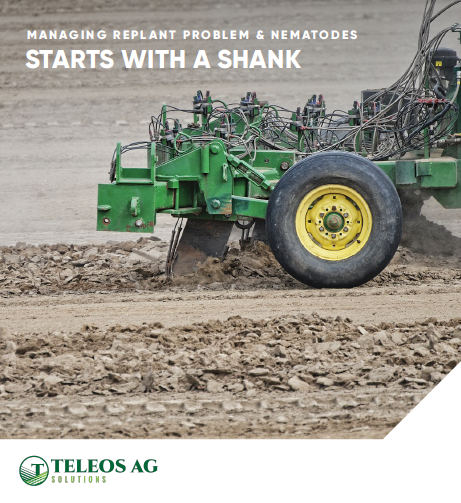A Way to Grow More Grapes With Less Water

To create direct root zone irrigation, PVC pipe is inserted vertically in a pre-drilled hole from 1 to 3 feet. Water, supplied through spaghetti tubing, is connected to a pressure-compensated emitter inserted into the overhead water supply line. Pictured is Pete Jacoby’s study on an established ‘Cabernet Sauvignon’ vineyard.
Photo by Pete Jacoby
Direct root zone irrigation — or DRZ—isn’t a new concept in horticulture. Pea tape in vegetable plantings, for example, is very common. So, when Pete Jacoby, a Professor and Plant Ecologist at Washington State University (WSU), started to look at how DRZ would work in commercial vineyards, he hoped to see how much water he could save with direct application.
DRZ is exactly what it sounds like — making water available deeper into the ground with the thought that this system would use less water and help growers achieve better quality grapes. It’s good news for grape growers in areas where water availability is going to become increasingly more critical.
As more and more vineyards are being planted in Washington in areas with junior water rights, water availability can become a concern, so growers need to be as efficient as possible.
“If you’re in an area that’s going to be faced with a severe water shortage on a chronic basis, it’s probably a pretty viable way to deal with that,” says Scott Williams, owner of Kiona Vineyards in Benton City, WA. “The push for any type of high-value, high-dollar crop is how can you come up with a better crop with less inputs and less cost.”
How Direct Root Zone Irrigation Works
Jacoby’s DRZ system avoids the use of buried drip lines. Instead, a short section of PVC pipe is inserted vertically into a pre-drilled hole to a depth of 1 to 3 feet. Water is supplied via a length of ¼-inch spaghetti tubing connected to a pressure-compensated emitter inserted into the overhead water supply line. Water drips into the vertical PVC tube and is delivered directly to the lower root zone of the vine.
Jacoby says installing the tubes is very easy to do in the dormant season, even with established vineyards.
For his initial study in 2015, he compared vine responses to water delivery at 1, 2, and 3 feet below the soil surface; then, he slashed water rates to 60%, 30%, and 15% of the surface drip application. Each vine is watered with a pair of tubes placed about 1.5 feet on either side of its base.
“Little did I know at that time, 2015 would be hottest and driest year on record in our area,” he says. “There were some nervous moments, needless to say, as vines begin to exhibit some water stress.”
Jacoby also compared constant irrigation and pulse irrigation, which had been successfully deployed in almonds in California.
“We found no differences attributed to whether it was constant or pulse, and we saw no differences among the three depths,” he says. “Under frequent surface-drip irrigation events, the plant reaches a certain stress level between irrigation events and when it’s irrigated, it gets relief – it does this as frequently as you’re irrigating – putting that vine into a state of feast and famine. Subsurface irrigation produces a more gradual level of stress from what we have observed compared to surface drip, so we can moderate the stress impacts that occur between irrigation events.”
Williams says there are some added benefits to the system, which include less damage from coyotes that seem to enjoy chewing on drip tube containing water.
“If you have a delivery system that is basically underground, then you don’t have things eating at your drip tube,” he says. “One of the benefits of that system is it doesn’t put much moisture on top of the ground, if any – the weeds don’t grow. Weeds become a very minor issue – where in most applications, it takes a fair amount of time and effort.”
Promising Results
The research showed, at least at the 65% level, there’s virtually no difference in yield or quality, Williams says.
Jacoby collaborated with Sindhuja Sankaran and Lav Khot, both professors in in WSU’s Department of Biological Systems Engineering, to use drones and remote sensing to detect plant stress. Jacoby’s team also measured stem water potential to monitor vine stress.
“The results lined up beautifully,” he says.
Jacoby’s research team has also put a camera down a clear acrylic tube to look at root response. Starting in 2016 Jacoby’s team began submitting samples of grapes harvested for quality analysis.
“One of the observations is that we can not only maintain production, but we can increase quality – especially for red grapes,” he says.
The stressed grapes showed higher Brix, anthocyanins, tannins, and more neutral acidity.
Jacoby’s study was on about 1¼ acres of 8-year-old ‘Cabernet Sauvignon’ vines and a newly planted block of ‘Chardonnay’ vines. Since the older ‘Cabernet’ vines had a more established root system, the effects of direct root zone irrigation took longer to show up.
“The ‘Chardonnay’ were young plants and they immediately responded to it because they were growing and establishing their roots,” he says. “The beauty of DRZ is you can go into an established vineyard and not have to do much disturbance to it to put the system in.”
In 2017, Jacoby changed the irrigation rates to 80%, 60%, and 40%, and eliminated pulse irrigation. While the official results of that study have been submitted for peer review, he’s confident the proof is in the pudding.
“Water savings on average is 30%, but I think that’s a conservative figure and our upcoming work will shed some more light on that,” he says. “By putting water deeper, I believe some of the things we are going to be able to show is that we can probably extend the length between irrigation events and more effectively control the level of stress on vines.”
Future Research
Jacoby says he is working with a team at WSU to develop a DRZ system that will be commercialized. He says this improved system will be efficient and cost-effective. He hopes to have it available by 2020. He’s also working on an economic study to study the cost of DRZ and the return on investment.
“My end goal is to try to get the device into the hands of growers. Not only do it efficiently but also at reduced cost for the grower,” he says. “We’re not done with this; we’re just getting started.”
Jacoby’s quick to point out that these results would not be possible without the financial assistance of the Washington Winegrowers Association and the Washington State Wine Commission.
Williams says that when it comes to producing high-quality wine grapes, it goes back to the old adage — if you’re not moving forward, you’re moving backward.
“Even if you’ve done it for a lifetime,” he says, “that doesn’t mean there aren’t other ways to accomplish the same thing in a better way.”











